Disclosure: This post may contain affiliate links. I may earn a small commission for my endorsement, recommendation, testimonial, and/or link to any products or services from this website.
This Thai Curry Noodle dish brings the inspired flavors of Thailand to your home kitchen. Deliciously bouncy noodles tossed in a vibrant yellow curry stir fry sauce and tons of veggies. Vegan, Gluten-Free option.
These Thai Curry Noodles are the perfect easy dinner for busy weeknights. The dish combines thick and chewy rice noodles with tender veggies, puffed tofu, and a simple curry stir fry sauce that’s packed with so. much. flavor. All you need is 30 minutes and a big appetite!
Table of Contents
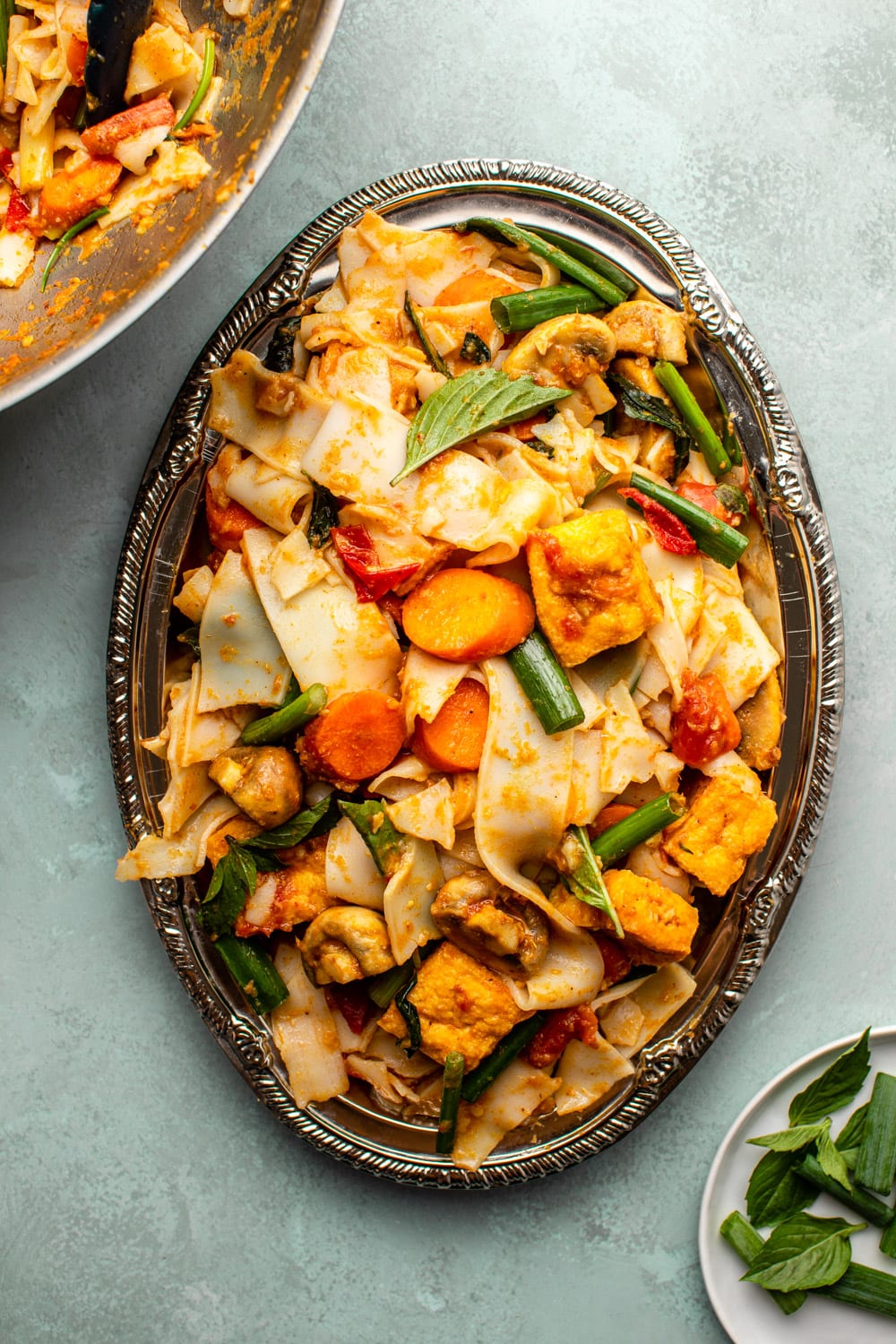
All About these Thai Curry Noodles
These noodles are inspired by the Yellow Curry Noodles I had at a local Thai restaurant called Wild Rose Thai while on a trip to Bend, Oregon! Unlike most of the soup-like curries you’re likely familiar with (like this Thai-Inspired Tofu Pineapple Curry or this Coconut Curry Lentil Soup), the noodles were more of a dry stir fry (similar to Pad See Ew!).
It was such a memorable dish, I knew I had to recreate my own Thai-inspired version for the blog! From the bouncy, thick, chewy rice noodles to the flavor-packed yellow curry paste, crispy tofu, tender veggies, and flavorful aromatics, there isn’t one component of this dish that won’t knock your socks off.
It’s the ultimate weeknight meal to whip up when you’re craving the comforting flavors of Thai food!
Ingredients for Thai Curry Noodles
You’ll need just a few simple ingredients to make flavorful Thai Curry Noodles at home:
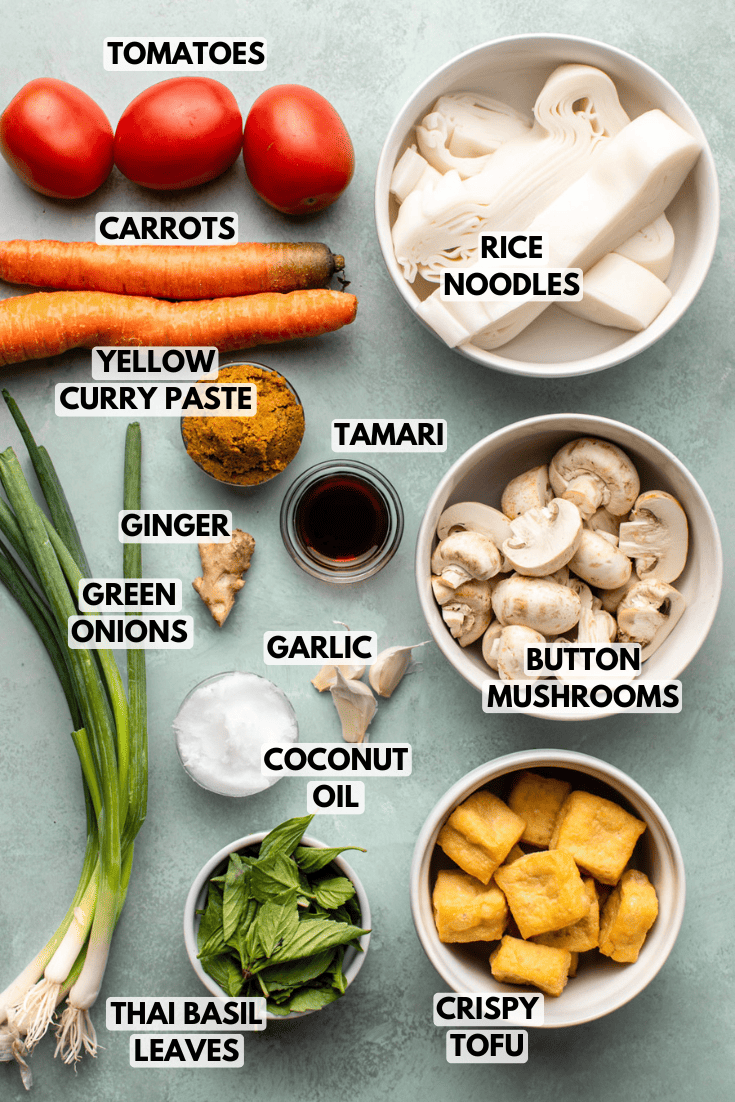
- Rice noodles: Key for the ultimate thick, chewy texture! You can find fresh rice noodles in the refrigerated section of most Asian grocery stores (they’re also known as rice noodle rolls). If you’re local to Vancouver, WA, I purchase my noodles from Tola Angkor Asian Market.
- Aromatics: The flavorful base of the stir fry sauce is made from green onions, fresh garlic, finely minced fresh ginger, and Thai basil.
- Curry paste: I used yellow curry paste to mimic the flavor in the noodles I had at Wild Rose Thai, but red curry paste would be a great alternative. Double check the ingredients of any curry paste you buy, as some contain fish, shrimp paste, and other non-vegetarian ingredients.
- Vegetables: You’ll need Roma tomatoes, brown button mushrooms, and carrots (or any vegetables of choice!).
- Tofu: I’d recommend super firm tofu, tofu puffs (often found at your local Asian grocery store), or homemade Crispy Tofu!
- Soy sauce: Adds rich umami-packed flavor, as well as the perfect saltiness. I use reduced sodium soy sauce as curry paste typically contains a lot of sodium, but feel free to increase or use full-sodium as needed.
- Sugar: Palm sugar, brown sugar, or coconut sugar will all work well! In a pinch, I’d also recommend trying a liquid sweetener such as pure maple syrup.
Looking for a recipe that uses Homemade Thai Green Curry Paste? Try this Best-Ever Thai Green Curry Recipe!
How to Make Thai Curry Noodles
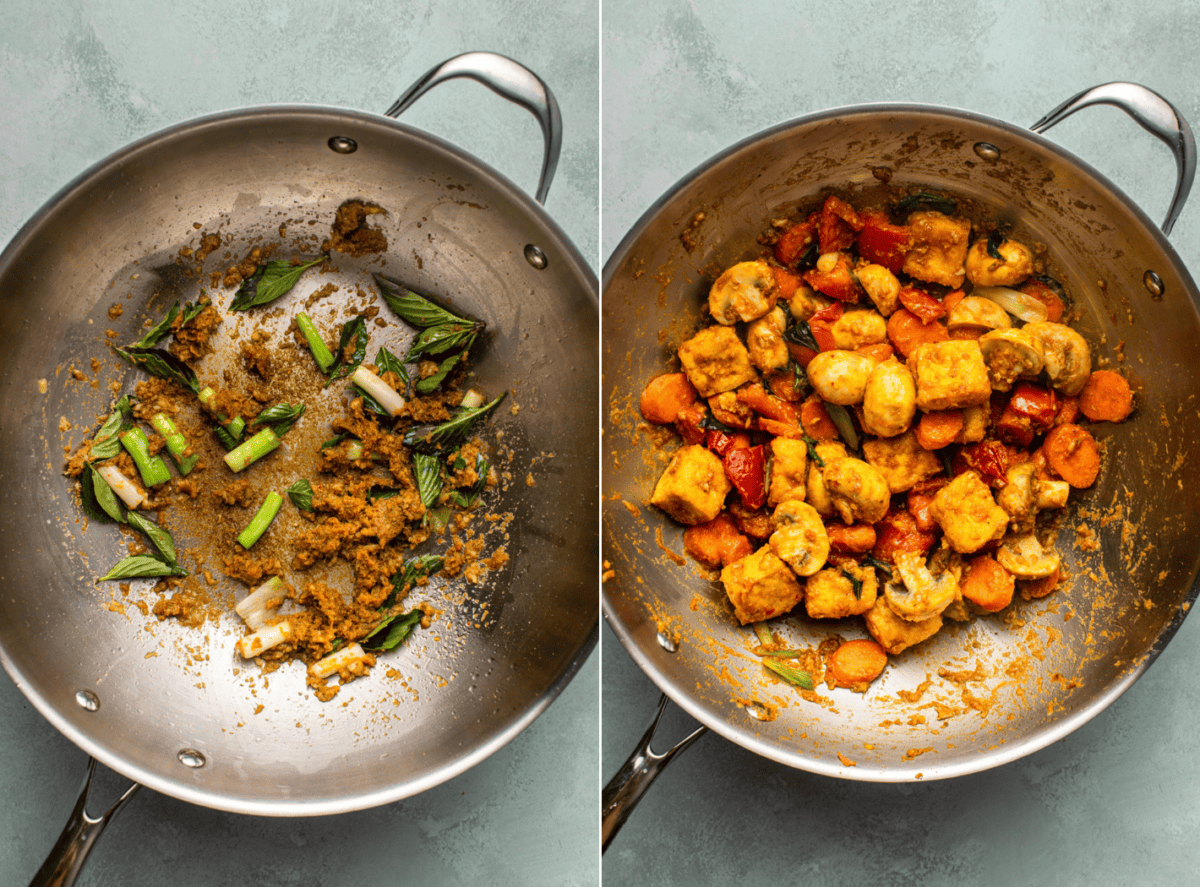
- Soak or cook the noodles according to package instructions. Drain and set aside.
- In a large wok, sauté the aromatics in warm coconut oil. Stir in the curry paste and fry for one minute.
- Add the vegetables and tofu and sauté until the carrots are cooked to your liking.
- While the veggies cook, make the stir fry sauce and pour into the wok.
- Add the cooked rice noodles and gently toss to combine.
- Finally, toss in the remaining green onion and Thai basil and serve immediately while warm!
Caitlin’s Cooking Tips
- Using fresh rice noodle “rolls” is highly recommended! These rice noodles are made with a few additional ingredients like wheat starch and tapioca flour, which gives them a deliciously bouncy texture and prevents breakage.
- Time the rice noodles to be ready right before tossing altogether. If the noodles sit too long,, they will begin to stick together and will break more easily.
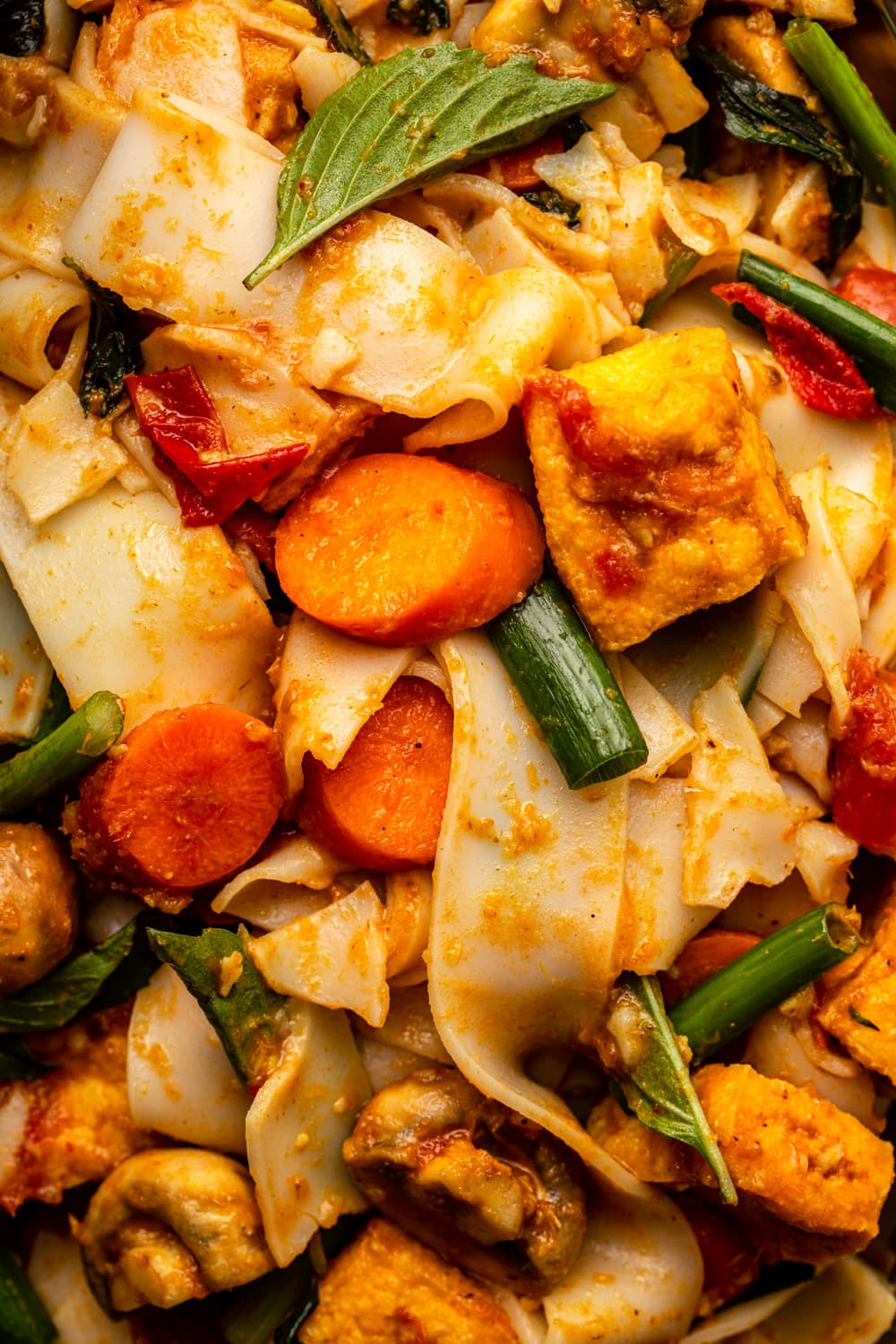
Serving Suggestions
These curry noodles are hearty enough to enjoy on their own as a stand-alone lunch or dinner, but can also be paired with additional sides. I’d recommend Vegan Summer Rolls or this 25-Minute Smashed Cucumber Salad for a global fusion.
If you’re looking for more Thai-inspired recipes, you’ll also love this Vegan Pad Thai, this Fresh Thai-Inspired Salad with Tempeh, and this Vegan Tofu Pineapple Curry!
How to Store Thai Curry Noodles
Once tossed together, these Thai Curry Noodles are best served immediately while warm as they break easily after refrigeration. If you are making this recipe for meal prep, make a big batch of veggies and sauce (steps 2-4) and cook the rice noodles individually right before serving.
Freezing is not recommended.
Substitutions and Variations
- Curry paste variations: Swap the yellow curry paste for red Thai curry paste. Or, go the homemade route and make your own curry paste: try this Red Curry Paste or this Yellow Curry Paste recipe.
- Noodle substitutes: If needed or gluten-free, replace the rice noodle rolls with wider dried rice noodles.
- Gluten-free option: Use dried rice noodles and reduced sodium tamari or another gluten-free soy sauce instead of reduced sodium soy sauce.
- Thai basil substitute: Thai basil has a unique flavor, and I wouldn’t recommend using Italian basil in place of it. Instead, add 1/4 cup chopped cilantro at the end for a different, but still delicious flavor.
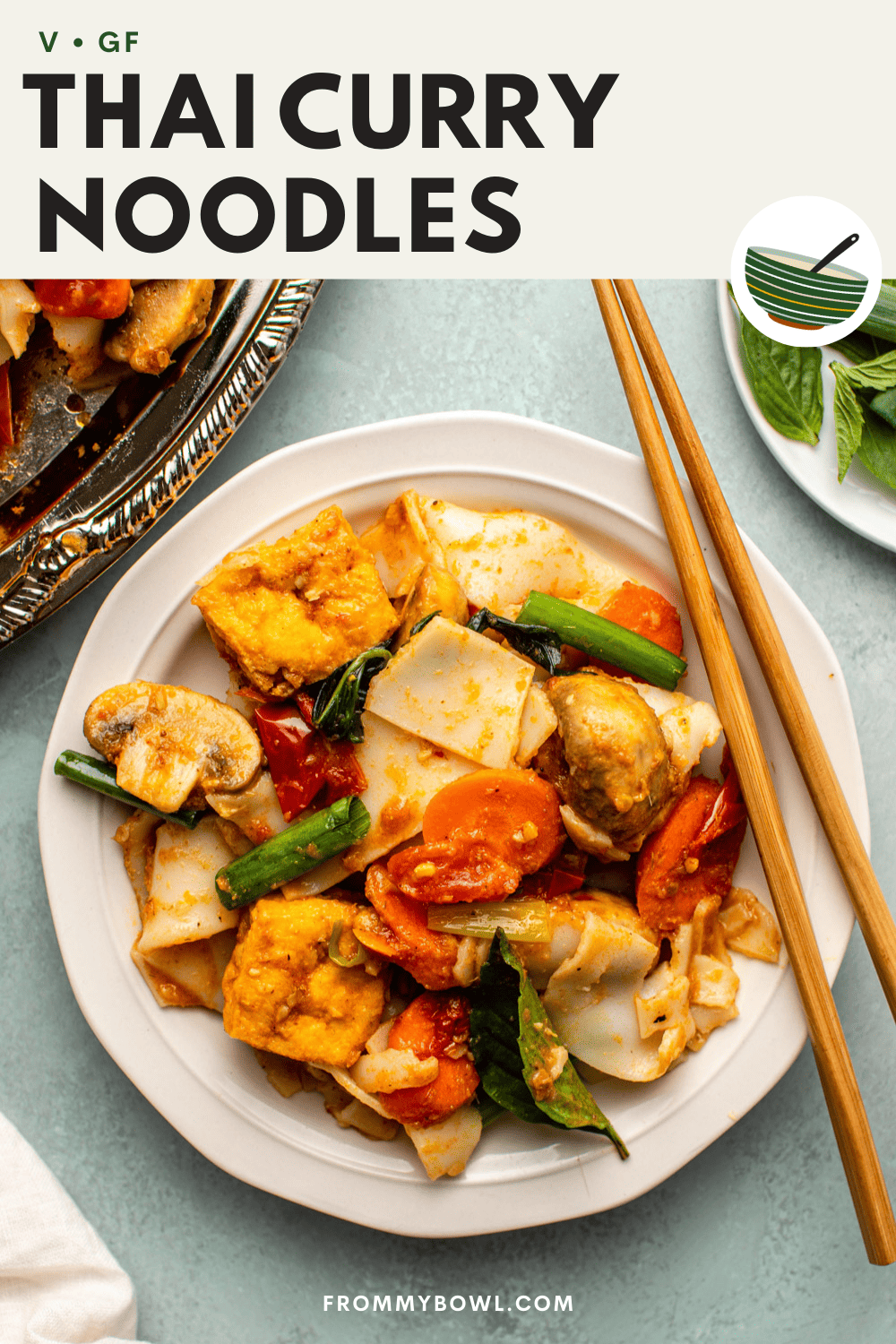
Recipe FAQs
I haven’t tested it, but tossing the stir fry sauce and vegetables with an equal amount of cooked white rice would likely work fine! Or, if you’re interested in Asian-inspired rice dishes, you might enjoy this Kimchi Fried Rice, this Vegan Takeout-Style Fried Rice, or this Dump & Bake Teriyaki Tofu Rice Casserole.
Fish sauce is a common ingredient in many Thai dishes, but it’s not required for a flavorful, umami-rich dish. This Thai curry noodle dish is not only fish sauce-free, but entirely vegan!
Depending on the yellow curry paste used, these noodles can range from mild to hot. If you are sensitive to heat, I’d recommend looking for a yellow curry that is labeled as mild and reducing the ginger to a 1/4-inch piece to start.
Enjoy! If you make this recipe and decide to share it on Facebook or Instagram, don’t forget to tag me @FromMyBowl + #FromMyBowl! I would also love it if you could leave a comment below with a recipe rating! Thank you for the support 😊
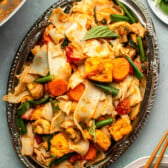
Thai Curry Noodles
Ingredients
- 1 lb fresh rice noodles OR 8 ounces (225 g) dried wide rice noodles
- 2 tablespoons coconut oil or high-heat oil
- 5 green onions cut into ½”pieces; white and green parts divided
- 3 cloves garlic minced
- 1/2" piece of ginger peeled and finely minced
- 3 tablespoons yellow curry paste*
- 1/2 cup thai basil leaves divided*
- 3 roma tomatoes cut into bite-sized pieces
- 6 ounces button mushrooms cut in half or quartered
- 2 carrots sliced
- 6-8 ounces super firm tofu tofu puffs, or Crispy Tofu
- 1 tbsp reduced sodium soy sauce or tamari
- 2 teaspoons palm sugar brown sugar, or coconut sugar
- 1/4 cup hot water
Instructions
- Cook the Noodles: Soak your fresh noodles in boiling water for 3-5 minutes OR if using dried noodles, bring a large pot to water to a boil and cook according to package directions. Drain and set aside. Note: I recommend timing the cooking of the noodles to line up with the completion of step 5, as rice noodles will begin to stick and break more easily if they sit for too long.
- Aromatics: Warm a wok or large sauté pan over medium-high heat. Add the oil and warm, then add the white portions of the green onions, garlic, ginger, and around half of the thai basil. Stir, then add the curry paste and fry for 1 minute, to enhance its flavor.
- Sauté the Vegetables: Add the tomato, mushrooms, carrot, and tofu. Stir well, until all of the veggies are evenly coated in the curry paste. Sauté for 5 to 7 minutes, stirring occasionally, until the carrots are cooked to your liking. Reduced the heat to medium.
- Stir Fry Sauce: In the meantime, combine the soy sauce, sugar, and hot water in a small bowl. Stir with a spoon until the sugar has dissolved, then pour into the wok once the veggies have finished cooking and stir well, to create a sauce.
- Combine: Add the cooked rice noodles to the veggie mixture and use tongs to distribute the veggies and gently toss the noodles in the sauce. Turn the heat off, then add the remaining green onion and thai basil and toss again.
- Serve: Serve immediately and enjoy warm.
Recipe Notes
- Curry Paste: I like to use this yellow curry paste, but you can also use red curry paste instead, which can be found in the Asian section of most grocery stores. Double check the ingredients of any curry paste you buy, as some contain fish or shellfish.
- Rice Noodles: You can find fresh rice noodles in the refrigerated section of most Asian grocery stores (also known as rice noodle rolls). They have a slightly thicker and chewier texture which I prefer, but if you are gluten-free or cannot find them, a wider dried rice noodle will also work!
- Thai Basil: Thai basil has a unique flavor, and I wouldn’t recommend using Italian basil in place of it. Instead I’d recommend using 1/4 cup of chopped cilantro for a different (but still delicious flavor!) – add the cilantro only as a garnish with the green onions in step 5.
- Gluten-Free: Use dried rice noodles and tamari or gluten-free soy sauce to make this recipe gluten-free!
- Leftovers: If you want to make this recipe for meal prep, I’d recommend following steps 2-4 and making a big batch of veggies and sauce. I’d cook each portion of rice noodles individually and right before serving, as they break easily after refrigeration.
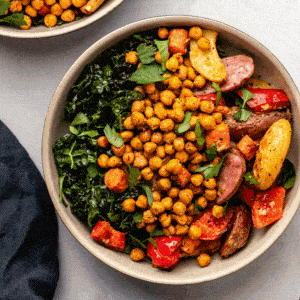




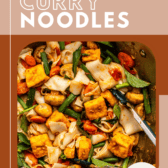


how much hot water do you add?
Typically, you’d start with a small amount (e.g., 2-3 tablespoons) and adjust to achieve the desired consistency for the sauce. Start with less water, and if needed, you can add more to reach the desired thickness.